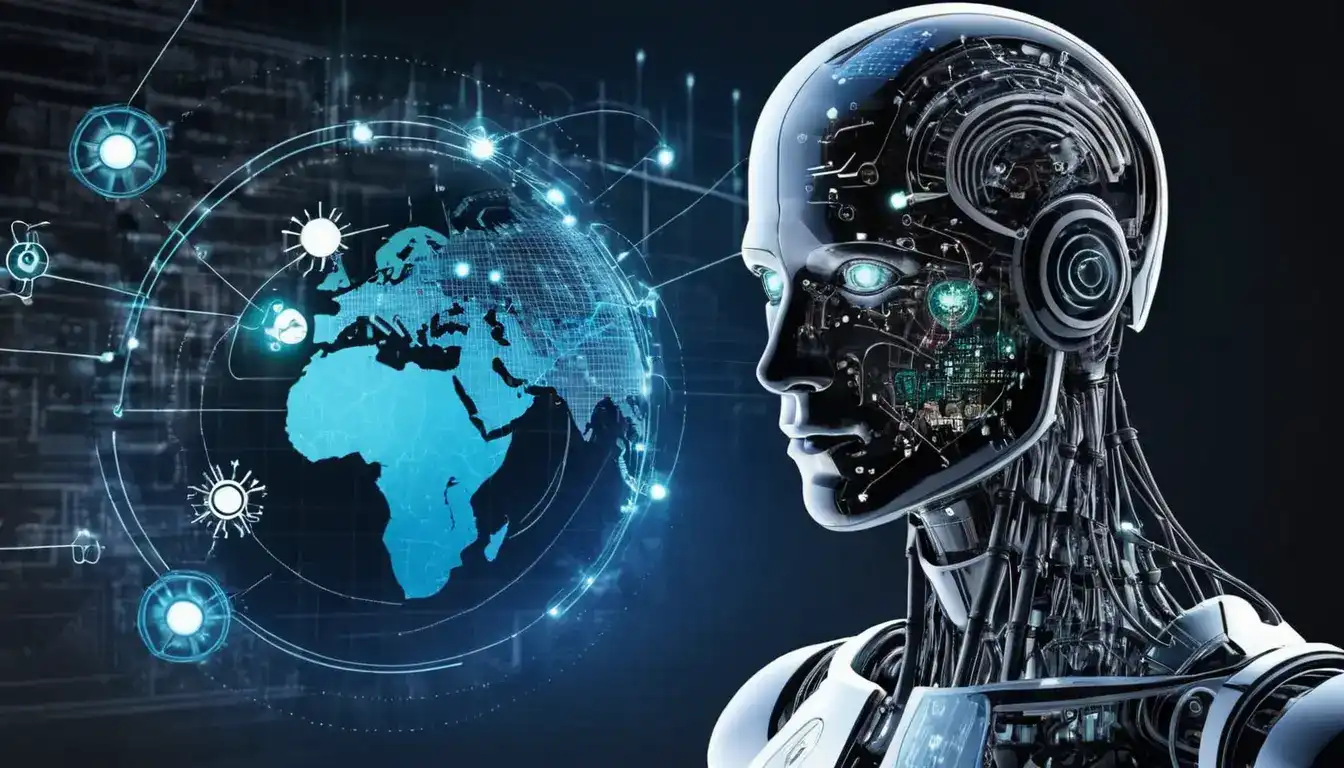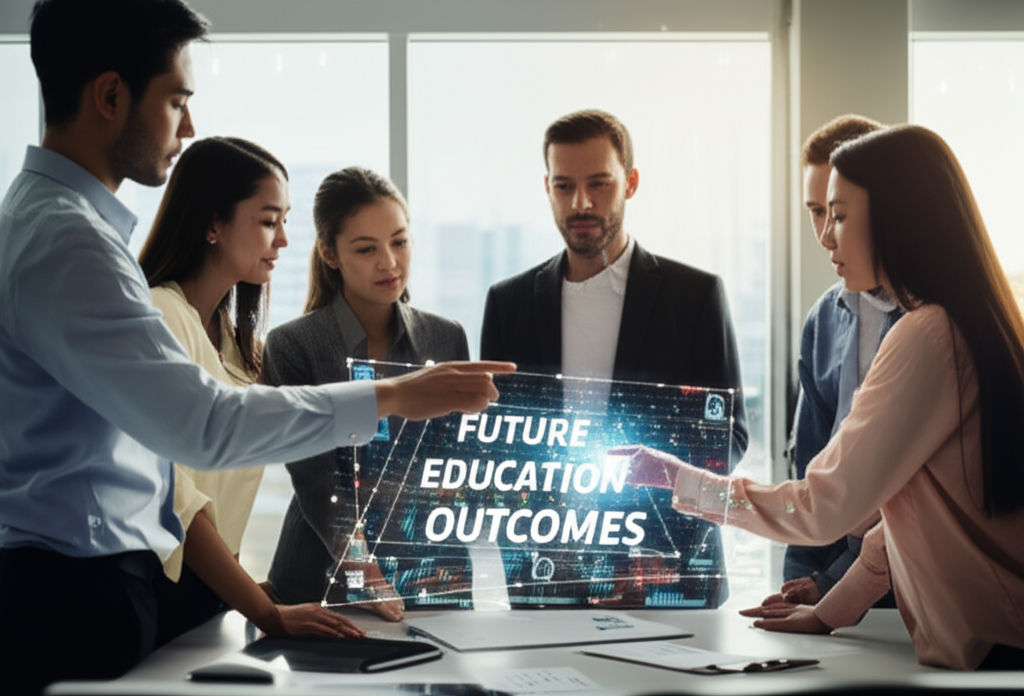Silos to Synergy: Interdisciplinary Learning
Emily Willis

Photo: Silos to Synergy: Interdisciplinary Learning
From Silos to Synergy: Unlocking the Power of Interdisciplinary Learning
Ever felt like the world around you operates in neat, separate boxes? Like your work, your hobbies, and your knowledge all exist in their own distinct compartments? This feeling often stems from what we call "silos" – isolated areas of expertise or activity that rarely connect. But here's the exciting truth: the most innovative and impactful solutions emerge when we break down silos and embrace interdisciplinary learning. It's about combining different fields to create something far greater than the sum of its parts, fostering true synergy in how we learn, work, and live.
In a world that's becoming increasingly complex, specialized knowledge alone often isn't enough. We need to connect the dots, draw insights from diverse perspectives, and cultivate a holistic understanding to tackle real-world challenges. This article will explore the transformative power of interdisciplinary learning, showing you how to move from isolated knowledge to integrated understanding, leading to enhanced problem-solving, innovation, and personal growth.
What Exactly Are "Silos" in Learning?
Imagine a traditional school setting where math, science, history, and art are taught as completely separate subjects, with little to no overlap. Or consider a workplace where different departments—marketing, engineering, sales—rarely communicate or share insights. These are prime examples of "silos." In learning, a siloed approach means:
- Compartmentalized Knowledge: Information is kept within strict boundaries, making it hard to see how one subject relates to another. In traditional education, students often learn in a siloed format where each subject is taught independently.
- Limited Perspective: When you only view a problem through one lens, you miss out on crucial insights and potential solutions that might come from another field.
- Missed Connections: The real world rarely presents problems that fit neatly into a single academic discipline or professional category. Relying solely on specialized knowledge can hinder your ability to adapt and innovate.
Historically, education has often been structured in this compartmentalized way, with one teacher per room and every subject having its own dedicated time slot. While this offers organization, it can prevent a holistic understanding of complex issues.
The Power of "Synergy": Unpacking Interdisciplinary Learning
So, if silos are the problem, interdisciplinary learning is the powerful solution. It's an educational approach that actively integrates knowledge, methods, and insights from multiple disciplines to foster a more comprehensive understanding of complex subjects and real-world problems. Think of it not as adding subjects together, but as weaving them into a rich tapestry where connections spark innovative thought.
The concept of "synergy" in learning emphasizes collaboration, cooperation, and shared responsibility. It's about individuals or groups working together towards a common goal, where each person's strengths and skills complement those of others, leading to an outcome where the "whole is greater than the sum of its parts". When applied to learning, synergistic thinking means using what you know or can do to develop understandings that transfer across various contexts, connecting facts and concepts for deeper understanding.
Interdisciplinary learning goes beyond simply studying multiple subjects (multidisciplinary). While multidisciplinary approaches involve different disciplines working together, each drawing on their own knowledge, interdisciplinary learning aims for a true synthesis, integrating knowledge and methods to create new insights. It encourages students to actively engage with one another, share ideas, and build upon each other's knowledge and experiences, fostering critical thinking and problem-solving skills.
Why Breaking Down Silos Matters More Than Ever (The "Why")
In today's fast-paced world, the ability to connect disparate ideas and think across boundaries isn't just a nice-to-have skill; it's a necessity. Here's why embracing interdisciplinary learning is crucial for everyone:
The Complex World We Live In
Real-world challenges, like climate change, global pandemics, or economic crises, don't respect disciplinary boundaries. Addressing environmental issues, for instance, requires knowledge from biology, chemistry, economics, and social sciences, all working together. Similarly, analyzing national political poll numbers necessitates knowledge of math, geography, and social studies. Interdisciplinary learning prepares us to navigate these complexities by providing a more holistic understanding.
Innovation & Creativity Flourish at Intersections
Many groundbreaking ideas and solutions emerge precisely where different fields meet. Think about the creation of smartphones, which required expertise in engineering, design, software development, and human psychology. Interdisciplinary learning fosters creativity by encouraging individuals to think "outside the box" and approach problems from multiple angles. By exposing learners to diverse perspectives and problem-solving techniques, it sparks innovation and creativity.
Future-Proofing Your Skills for the Evolving Job Market
The job market is constantly changing, with new roles emerging that demand a blend of skills from various disciplines. Jobs like data scientists, market research analysts, and even physical therapists require the unique integration of different fields. Employers are increasingly looking for "outside the box thinkers" – individuals who have received an interdisciplinary education, capable of critical, creative thought beyond the boundaries of a single subject. Developing transferable skills such as critical thinking, communication, and analysis through interdisciplinary study is vital at all stages of life.
Enhanced Problem-Solving and Critical Thinking
When you can pull information and methods from various sources, your ability to solve problems skyrockets. Interdisciplinary learning encourages you to analyze and synthesize information from diverse sources, leading to enhanced critical thinking. It helps you break down complex problems into manageable parts and reconstruct solutions using tools from many disciplines, ultimately offering a more complete understanding of an issue.
How Interdisciplinary Learning Works in Practice (The "How")
Interdisciplinary learning isn't just a theory; it's a practical approach that can be implemented in various settings, from classrooms to boardrooms and even in your personal life.
In Education
Educational institutions are increasingly recognizing the value of interdisciplinary education to prepare students for the complexities of the modern world.
- Project-Based Learning: This is a fantastic way to integrate multiple subjects. For example, a project exploring the natural world could merge science (researching animal habitats), technology (coding animal animations), art (creating animal sketches and digital representations), and language arts (crafting poems about animals). Another example could be students determining probability using genetic conditions in dog breeds, drawing on both mathematics and science.
- Cross-Departmental Courses/Thematic Units: Universities and schools are designing courses that bring together instructors from different disciplines to co-teach, or organizing curricula around central themes like sustainability, which inherently draw from diverse academic fields.
- Case Studies: Using specific real-world cases or problems as a starting point allows students to explore multiple disciplines simultaneously. For instance, analyzing national political poll numbers can involve math, geography, and social studies.
In the Workplace
Breaking down organizational silos is crucial for fostering innovation and efficiency in professional environments.
- Cross-Functional Teams: Bringing together individuals from different departments (e.g., engineering, marketing, sales, design) to work on a single project fosters diverse perspectives and integrated solutions. This encourages collaboration and shared expertise.
- Knowledge Sharing Initiatives: Regular workshops, seminars, or internal platforms where employees from different areas can share their insights and learn from each other can bridge knowledge gaps and spark new ideas.
- Design Thinking: This human-centered approach to problem-solving often involves interdisciplinary teams collaborating to understand user needs, brainstorm solutions, and prototype ideas, drawing on insights from various fields like psychology, engineering, and business.
In Everyday Life
You don't need a formal classroom or a corporate setting to embrace interdisciplinary thinking.
- Curiosity-Driven Exploration: Allow your interests to lead you across different domains. If you're interested in cooking, explore the chemistry of ingredients, the history of cuisines, or the economics of food systems.
- Connecting Hobbies: See how your hobbies intersect. A passion for gardening might lead you to study botany (science), garden design (art), and local ecology (environmental studies).
- Reading Widely: Don't limit your reading to your professional field. Explore books, articles, and documentaries on diverse topics to broaden your perspective and make unexpected connections.
Actionable Steps to Embrace Interdisciplinary Learning (Your Journey from Silo to Synergy)
Ready to start your journey from compartmentalized thinking to synergistic understanding? Here are practical steps you can take:
For Students
- Explore Electives: Step outside your comfort zone and choose electives in subjects seemingly unrelated to your major. A science student might take a philosophy course, or an arts student could explore an introductory coding class.
- Join Interdisciplinary Clubs or Projects: Look for opportunities in school or online that bring together students from different academic backgrounds to work on a common goal, such as a robotics club that combines engineering, programming, and design, or a debate team that uses critical thinking and communication skills across various topics.
- Seek Diverse Mentors: Find mentors who have expertise in different fields. Their varied experiences can offer unique insights and guide you in connecting knowledge.
- Engage in Project-Based Learning: Actively seek out courses or opportunities that emphasize hands-on projects requiring you to integrate knowledge from multiple subjects.
For Professionals
- Collaborate Actively: Don't just work alongside colleagues from other departments; actively seek opportunities to collaborate on projects. Offer your expertise and be open to learning theirs.
- Pursue Cross-Training & Workshops: If your company offers training outside your immediate job function, take advantage of it. Look for online courses or workshops that bridge different skill sets.
- Read Beyond Your Field: Subscribe to industry publications from different sectors, or read books on topics like psychology, economics, or philosophy, even if your primary work is in technology. This broadens your perspective and fuels creative solutions.
- Attend Cross-Functional Meetings: If possible, ask to attend meetings
Latest ✨
View AllMaster the art of handling complaints effectively. Learn the psychology, actionable steps, and how to turn feedback into opportunities for growth and stronger r...
Emily Willis
Women's participation in sport has evolved into a powerful movement that challenges societal norms, empowers individuals, and promotes inclusivity. This article explores the journey of women in sport, highlighting their achievements, the obstacles they have overcome, and the transformative impact they continue to have in the world of sport and beyond.
Emily Willis
Beyond crypto hype: Understand digital asset economics. Learn core principles like supply, demand, scarcity & utility to navigate the market wisely.
Emily Willis
Redefining success in education means moving beyond grades. Learn how future outcomes focus on adaptability, critical thinking, and skills for an unpredictable...
Emily Willis
Business
View All
June 9, 2025
Risk Management: Protect Your BusinessUnlock business resilience! Master risk management to protect assets, enhance decision-making, minimize losses, and ensure sustainable growth in an uncertain wo...
Emily Willis

June 8, 2025
Entrepreneurial Journey to SuccessDemystify the entrepreneurial journey. This guide offers actionable strategies to transform ideas into thriving businesses, navigate challenges, and achieve las...
Emily Willis

June 8, 2025
Personalization in Business MarketingUnlock business growth! Learn how personalized marketing transforms interactions, boosts engagement & loyalty by speaking directly to your customers.
Emily Willis
Economy
View AllBuild your financial future! Demystify investing with smart, accessible strategies & practical tips for everyone to grow lasting wealth.
Read MoreInfrastructure development is crucial for driving economic growth and regional integration by improving connectivity, facilitating trade, and enhancing quality of life. Investments in transportation networks and digital infrastructure support businesses in accessing larger markets and capitalizing on trade opportunities. Well-developed infrastructure simplifies trade processes and attracts industries to specific regions, promoting economic development. Access to essential services and urban infrastructure improves quality of life and fosters sustainable urbanization. Green infrastructure projects support environmental conservation and contribute to sustainable development goals. Overall, strategic investments in infrastructure are essential for building resilient, inclusive, and prosperous communities in the global economy.
Read MoreUnlock historical wisdom and ancient philosophies for preventing depression. Learn timeless strategies for resilience and emotional balance in modern life.
Read MoreEntertainment
View All
August 5, 2024
Arts Education's Importance: Nurturing Creativity and Fostering ExpressionArts education is often overlooked in a world focused on standardized tests and STEM subjects, but it plays a vital role in nurturing creativity, self-expression, and essential skills in students. Arts education allows students to unleash creativity, build confidence, improve communication and collaboration skills, develop critical thinking and problem-solving abilities, increase cultural awareness and appreciation, and enhance emotional intelligence.
Emily Willis

August 5, 2024
Music Universal Language: Connecting and Inspiring Across CulturesMusic has the power to transcend language barriers and connect people on a deep emotional level. It serves as a bridge between cultures, fostering understanding and appreciation for diversity. The universality of rhythm and melody creates a sense of unity, while the diversity of musical styles allows for exploration and creativity.
Emily Willis

August 4, 2024
The Evolution of Digital Distribution in the Music Industry: Challenges and OpportunitiesThe music industry has been transformed by digital distribution, which allows quick access to a vast catalog of music through streaming services and online stores.
Emily Willis
Health
View AllRegular physical activity is crucial for maintaining long-term health and well-being. It has numerous benefits, including improving cardiovascular health, aiding in weight management, enhancing mental health, strengthening bones, boosting immune function, and promoting longevity.
Emily Willis
our minds are often overwhelmed with information and stimuli, leading to stress and anxiety. Mindfulness and meditation offer tools to cultivate inner peace and well-being. Mindfulness involves being present in the moment without judgment, while meditation involves focusing attention on an object or thought.
Emily Willis
Maintaining good health involves a balanced diet that provides essential nutrients for the body. A balanced diet includes carbohydrates, proteins, fats, vitamins, minerals, fiber, and water. Benefits of a balanced diet include enhanced energy levels, improved mental health, a stronger immune system, better weight management, reduced risk of chronic diseases, and enhanced digestion. Components of a balanced diet include fruits and vegetables, whole grains, protein sources, dairy or dairy alternatives, and healthy fats. Tips for maintaining a balanced diet include planning meals, portion control, staying hydrated, limiting processed foods, eating mindfully, and including physical activity.
Emily Willis
Trending 🔥
View All
1
3
4
5
7
8
9
10
Sports
View AllAugust 4, 2024
The Importance of Mental Training and Psychological Strategies in Helping Athletes Reach Their Peak Performance on the Field
Read MoreAugust 5, 2024
The Future of Sports: Anticipating Trends, Embracing Innovation, Shaping a New Era
Read MoreAugust 4, 2024
Sports Technology Innovation: Revolutionizing Training and Performance Analysis
Read MoreTechnology
View All
August 4, 2024
Exploring the Potential of Quantum Computing in Modern Technology
Quantum computing is a revolutionary technology that uses quantum bits, or qubits, to process information. It has the potential to solve complex problems, revolutionize cryptography, accelerate drug discovery, optimize complex systems, and enhance artificial intelligence.

August 5, 2024
Tips for Implementing Cloud Computing Safely and Efficiently
Cloud computing is essential for modern businesses, offering cost savings, scalability, and improved collaboration. Implementing cloud computing requires careful planning to ensure safety and efficiency. Tips for safe and efficient implementation include conducting a needs assessment, choosing the right cloud service model, prioritizing security, planning for data migration, optimizing costs, training your team, implementing backup and recovery solutions, monitoring performance, planning for scalability, and staying updated with industry trends.

August 5, 2024
Oculus Quest 2 vs HTC Vive Pro – Which Should You Choose?
Oculus Quest 2 vs HTC Vive Pro – which VR headset reigns supreme? Dive into this ultimate showdown to discover the strengths and weaknesses of each, and decide which one is worth your investment. From specs and comfort to content and price, we'll help you make an informed choice.

August 5, 2024
AI Applications that are Changing the World Around Us
Artificial Intelligence (AI) is no longer a concept from science fiction, but a reality that is reshaping the world around us. From virtual assistants to self-driving cars, AI is making significant impacts in various industries such as healthcare, education, transportation, and agriculture. AI is also being used to address environmental challenges and enhance customer experiences.





















